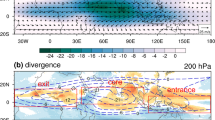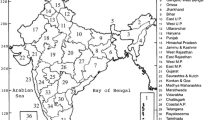Abstract
The East Asian winter monsoon in 2018 winter is characterized by below-normal surface air temperature (SAT) over central Siberia and eastern China when the winter mean is considered and by three cold waves when the intraseasonal variability, whose timescale is shorter than a season, is concerned. The three cold waves only consist of approximately 2 weeks, but they play a primary role in shaping the SAT pattern in the winter mean field. Nevertheless, the atmospheric circulation anomalies that shape the SAT pattern during the cold waves cannot be reflected well in the winter mean fields. It leads to insufficiencies to explain the winter mean SAT pattern by examining the winter mean circulation alone. In contrast, the SAT pattern formation can be better interpreted when the role of cold waves is considered. These results suggest that the common approach in climate science to examine the seasonal mean variables alone in understanding the seasonal behaviors of climate misses some crucial aspects, at least for this particular winter, and that the intraseasonal variability should be taken into account to supplement these missing aspects. It is recommended that the influences of intraseasonal variability on the climatic behavior of the East Asian winter monsoon be studied comprehensively in the future to portrait a complete picture of this issue.







Similar content being viewed by others
References
Chang CP, Lu MM (2012) Intraseasonal predictability of Siberian High and East Asian winter monsoon and its interdecadal variability. J Clim 25:1773–1778
Chang CP, Harr PA, Chen HJ (2005) Synoptic disturbances over the equatorial South China Sea and western Maritime Continent during boreal winter. Mon Weather Rev 133:489–503
Chang CP, Wang Z, Hendon H (2006) The Asian winter monsoon. In: Wang B (ed) The Asian monsoon. Springer Praxis Books. Springer, Berlin, pp 89–127
Chang CP, Lu MM, Wang S (2011) The East Asian winter monsoon. In: Chang CP, Ding YH, Lau NC, Johnson RH, Wang B, Yasunari T (eds) The global monsoon system: research and forecast, 2nd edn. World Scientific, Singapore, pp 99–109
Chen W, Li T (2007) Modulation of Northern hemisphere wintertime stationary planetary wave activity: East Asian climate relationships by the Quasi-Biennial Oscillation. J Geophys Res 112:D20120. https://doi.org/10.1029/2007JD008611
Chen W, Graf HF, Huang R (2000) The interannual variability of East Asian winter monsoon and its relation to the summer monsoon. Adv Atmos Sci 17:48–60
Chen W, Yang S, Huang R (2005) Relationship between stationary planetary wave activity and the East Asian winter monsoon. J Geophys Res 110:D14110. https://doi.org/10.1029/2004JD005669
National Climate Center (2018) China climate impact assessment. National Climate Center, China Meteorological Administration. Report No. 12. 14
Efron B, Tibshirani RJ (1994) An introduction to the bootstrap. Chapman and Hall/CRC, New York
Fan H, Wang L, Zhang Y, Tang Y, Duan W, Wang L (2020) Predictable patterns of wintertime surface air temperature in Northern Hemisphere and their predictability sources in the SEAS5. J Clim 33:10743–10754
Gong Z, Feng G, Ren F, Li J (2014) A regional extreme low temperature event and its main atmospheric contributing factors. Theor Appl Climatol 117:195–206
Hartmann DL (2002) Climate. In: Holton JR, Pyle J, Curry JA (eds) Encyclopedia of atmospheric sciences. Academic Press, New York, pp 403–411
Honda M, Inoue J, Yamane S (2009) Influence of low Arctic sea-ice minima on anomalously cold Eurasian winters. Geophys Res Lett 36:L08707. https://doi.org/10.1029/2008GL037079
Hu K, Huang G, Wu R, Wang L (2018) Structure and dynamics of a wave train along the wintertime Asian jet and its impact on East Asian climate. Clim Dyn 51:4123–4137
Inoue J, Hori ME, Takaya K (2012) The role of Barents sea ice in the wintertime cyclone track and emergence of a Warm-Arctic Cold-Siberian anomaly. J Clim 25:2561–2568
Jian Y, Lin X, Zhou W, Jian M, Leung MYT, Cheung PKY (2020) Analysis of record-high temperature over Southeast coastal China in winter 2018/19: the combined effect of mid- to high-latitude circulation systems and SST forcing over the north Atlantic and tropical western Pacific. J Clim 33:8813–8831
Kobayashi S, Ota Y, Harada Y, Ebita A, Moriya M, Onoda H, Onogi K, Kamahori H, Kobayashi C, Endo H, Miyaoka K, Takahashi K (2015) The JRA-55 reanalysis: General specifications and basic characteristics. J Meteorol Soc Jpn Ser II 93:5–48
Lau NC, Holopainen EO (1984) Transient eddy forcing of the time-mean flow as identified by geopotential tendencies. J Atmos Sci 41:313–328
Lee JY, Lee SS, Wang B, Ha KJ, Jhun JG (2013) Seasonal prediction and predictability of the Asian winter temperature variability. Clim Dyn 41:573–587
Li X, Wen Z, Huang WR (2020) Modulation of south Asian jet wave train on the extreme winter precipitation over Southeast China: comparison between 2015/16 and 2018/19. J Clim 33:4065–4081
Liu Y, Wang L, Zhou W, Chen W (2014) Three Eurasian teleconnection patterns: spatial structures, temporal variability, and associated winter climate anomalies. Clim Dyn 42:2817–2839
Liu Q, Chen G, Wang L, Kanno Y, Iwasaki T (2021) Southward cold airmass flux associated with the East Asian winter monsoon: diversity and impacts. J Clim. https://doi.org/10.1175/JCLI-D-20-0319.1
Luo D, Xiao Y, Diao Y, Dai A, Franzke CLE, Simmonds I (2016a) Impact of ural blocking on winter warm Arctic-Cold Eurasian anomalies. Part II: the link to the North Atlantic oscillation. J Clim 29:3949–3971
Luo D, Xiao Y, Yao Y, Dai A, Simmonds I, Franzke CLE (2016b) Impact of ural blocking on winter Warm Arctic-Cold Eurasian anomalies. Part I: blocking-induced amplification. J Clim 29:3925–3947
Ma S, Zhu C (2019) Extreme cold wave over East Asia in January 2016: a possible response to the larger internal atmospheric variability induced by Arctic warming. J Clim 32:1203–1216
Miyazaki C, Yasunari T (2008) Dominant interannual and decadal variability of winter surface air temperature over Asia and the surrounding oceans. J Clim 21:1371–1386
Mori M, Watanabe M, Shiogama H, Inoue J, Kimoto M (2014) Robust Arctic sea-ice influence on the frequent Eurasian cold winters in past decades. Nat Geosci 7:869–873
Nakamura H, Nishii K, Wang L, Orsolini YJ, Takaya K (2016) Cold-air outbreaks over East Asia associated with blocking highs: mechanisms and their interaction with the polar stratosphere. In: Li J, Swinbank R, Grotjahn R, Volkert H (eds) Dynamics and predictability of large-scale high-impact weather and climate events. Cambridge University Press, Cambridge, pp 225–236
Oldenborgh GJV, Mitchell-Larson E, Vecchi GA, Vries HD, Vautard R, Otto F (2019) Cold waves are getting milder in the northern midlatitudes. Environ Res Lett 14:114004. https://doi.org/10.1088/1748-9326/ab4867
Shen H, Zhao J, Cheung KY, Chen L, Yu X, Wen T, Gong Z, Feng G (2021) Causes of the extreme snowfall anomaly over the northeast Tibetan plateau in early winter 2018. Clim Dyn 56:1767–1782
Song L, Wang L, Chen W, Zhang Y (2016) Intraseasonal variation of the strength of the East Asian trough and its climatic impacts in boreal winter. J Clim 29:2557–2577
Sun C, Yang S, Li W, Zhang R, Wu R (2016) Interannual variations of the dominant modes of East Asian winter monsoon and possible links to Arctic sea ice. Clim Dyn 47:481–496
Takaya K, Nakamura H (2005) Mechanisms of intraseasonal amplification of the cold Siberian High. J Atmos Sci 62:4423–4440
Takaya K, Nakamura H (2013) Interannual variability of the East Asian winter monsoon and related modulations of the planetary waves. J Clim 26:9445–9461
Tian B, Fan K, Yang H (2018) East Asian winter monsoon forecasting schemes based on the NCEP’s climate forecast system. Clim Dyn 51:2793–2805. https://doi.org/10.1007/s00382-017-4045-7
Wang L, Chen W (2014a) The East Asian winter monsoon: re-amplification in the mid-2000s. Chin Sci Bull 59:430–436
Wang L, Chen W (2014b) An intensity index for the East Asian winter monsoon. J Clim 27:2361–2374
Wang L, Feng J (2011) Two major modes of the wintertime precipitation over China. Chin J Atmos Sci 35:1105–1116
Wang L, Lu MM (2017) The East Asian winter monsoon. In: Chang CP, Kuo HC, Lau NC, Johnson RH, Wang B, Wheeler MC (eds) The global monsoon system: research and forecast, 3rd edn. World Scientific, Singapore, pp 51–61
Wang B, Wu R, Fu X (2000) Pacific-East Asian teleconnection: how does ENSO affect East Asian climate? J Clim 13:1517–1536
Wang L, Huang R, Gu L, Chen W, Kang L (2009) Interdecadal variations of the East Asian winter monsoon and their association with quasi-stationary planetary wave activity. J Clim 22:4860–4872
Wei W, Wang L, Chen Q, Liu Y (2014) Interannual variations of early and late winter temperatures in China and their linkage. Chin J Atmos Sci 38:524–536
Wei W, Wang L, Chen Q, Liu Y, Li Z (2020) Definition of early and late winter and associated interannual variations of surface air temperature in China. Chin J Atmos Sci 44:122–137
Wu R, Hu ZZ, Kirtman BP (2003) Evolution of ENSO-related rainfall anomalies in East Asia. J Clim 16:3742–3758
Wu B, Su J, Zhang R (2011) Effects of autumn-winter Arctic sea ice on winter Siberian High. Chin Sci Bull 56:3220–3228
Wu J, Liu Q, Cui QY, Xu DK, Wang L, Shen CM, Chu GQ, Liu JQ (2019) Shrinkage of East Asia winter monsoon associated with increased ENSO events since the mid-Holocene. J Geophys Res Atmos 124:3839–3848
Xiao D, Zuo Z, Zhang R, Zhang X, He Q (2018) Year-to-year variability of surface air temperature over China in winter. Int J Climatol 38:1692–2170
Yang S, Li T (2016) Intraseasonal variability of air temperature over the mid-high latitude Eurasia in boreal winter. Clim Dyn 47:2155–2175
Yao Y, Luo D, Dai A, Simmonds I (2017) Increased quasi stationarity and persistence of winter Ural blocking and Eurasian extreme cold events in response to Arctic warming. Part I: insights from observational analyses. J Clim 30:3549–3568
Žagar N, Zaplotnik Z, Karami K (2020) Atmospheric subseasonal variability and circulation regimes: spectra, trends and uncertainties. J Clim 33:1–42
Zhang R, Sumi A, Kimoto M (1996) Impact of El niño on the East Asian monsoon: a diagnostic study of the ’86/87 and ’91/92 events. J Meteorol Soc Jpn 74:49–62
Zhang R, Sumi A, Kimoto M (1999) A diagnostic study of the impact of El niño on the precipitation in China. Adv Atmos Sci 16:229–241
Zhou B, Gu L, Ding Y, Shao L, Wu Z, Yang X, Li C, Li Z, Wang X, Cao Y, Zeng B, Yu M, Wang M, Wang S, Sun H, Duan A, An Y, Wang X, Kong W (2011) The great 2008 Chinese ice storm: its socioeconomic-ecological impact and sustainability lessons learned. Bull Am Meteor Soc 92:47–60
Zuo Z, Zhang R, Huang Y, Xiao D, Guo D (2015) Extreme cold and warm events over China in wintertime. Int J Climatol 35:3568–3581
Acknowledgements
We thank the three anonymous reviewers for their insightful comments. This research is supported by the National Natural Science Foundation of China (41925020, 41721004) and the Chinese Academy of Sciences (QYZDY-SSW-DQC024).
Author information
Authors and Affiliations
Corresponding author
Additional information
Publisher's Note
Springer Nature remains neutral with regard to jurisdictional claims in published maps and institutional affiliations.
Rights and permissions
About this article
Cite this article
Wang, L., Zheng, C. & Liu, Y. Understanding the East Asian winter monsoon in 2018 from the intraseasonal perspective. Clim Dyn 57, 2053–2062 (2021). https://doi.org/10.1007/s00382-021-05793-x
Received:
Accepted:
Published:
Issue Date:
DOI: https://doi.org/10.1007/s00382-021-05793-x




